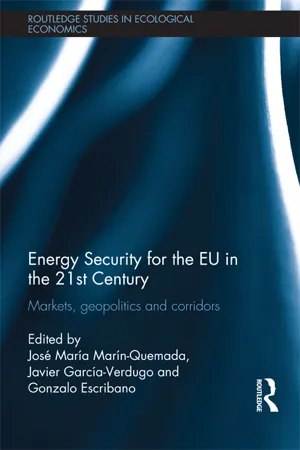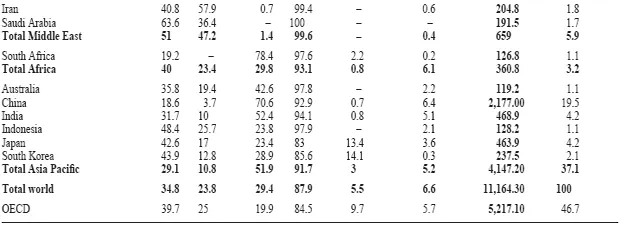![]()
Part I
Energy, geopolitics and
energy security
Qualitative and quantitative analysis
![]()
1
Global energy needs and resources
Geographical imbalances and energy security
Javier García-Verdugo and Laura Rodríguez
There is no further need to stress the importance of energy for the global economy. It is critical however to be aware that any policy decisions about energy should be based on a sound knowledge of the facts about the international energy industry. Apart from the strictly technical aspects of energy sources (calorific factors, production technologies, pollutants content by fuel and so on), the other fundamental feature of global energy is the unbalanced geographical distribution of reserves, production and consumption, so that international energy-related trade flows become essential for the energy security (see Chapter 2) of most countries.
This chapter will briefly review the basic statistical data of the world energy system – world energy demand, production and reserves – with a breakdown in each case by energy sources and by regions. We will begin with energy demand, since it can be argued that the energy industry – the activities of exploration, production, transport and distribution – follows the path set by energy consumption, which in turn is highly dependent on economic growth. Energy production patterns and fossil fuel reserves will be explored next. Finally, an analysis of international energy trade will connect supply origins with demand centres and will provide the basis for the in-depth analysis of energy corridors and energy security carried out in the rest of the book. The interaction between energy production and demand determines the short run equilibrium of the system, while the long run situation depends on the rate of growth of energy consumption and the expected variation in reserves.
In each section the statistical data will be provided for the main world regions – North America, Central and South America, Europe and Eurasia, Middle East, Africa and Asia Pacific – and for some selected countries in each region.1 Besides, aggregated data are included for different groups of countries – not geographical in nature – when it is considered useful for the analysis.2
Most of the following series of data are taken from BP's Statistical Review of World Energy (2010) and correspond to the end of 2009. Fortunately, this book refers to matters that are mostly structural in nature and policy oriented, so that its conclusions will hopefully be useful beyond the immediate future in spite of the inevitable updates of the statistical series.3
1.1 World energy demand
Above the evolution of individual energy sources and markets, the global economy is undergoing rapid structural change, with many developing countries trying to catch up with the income level of the countries belonging to the Organisation for Economic Co-operation and Development (OECD). Energy availability is essential for this transformation and energy data show that the worldwide economic crisis since 2007 did not change this trend.
Primary energy production is the extraction of energy from a natural source to satisfy final energy consumption, which is the energy consumed in the transport, industrial, commercial, agricultural, public and household sectors (European Commission, 2010b: 22). The term primary energy consumption can therefore be used to indicate the demand of primary energy – not directly usable by consumers – that has to be transformed into energy products that can be used by a country's consumers.
Primary energy sources usually comprise crude oil, natural gas, coal, nuclear energy and renewable energy sources (RES), i.e. biomass plus hydroelectric, wind, geothermal and solar power generation, among others. Following BP (2010) for the sake of simplicity, hydropower will be the only RES considered in this chapter. BP's Review does not consider biomass due to unreliable consumption statistics – although it is very important in many emerging economies, like Brazil or India, as well as in most developing countries – and similarly it does not take into account wind, solar or geothermal power due to their small relative importance (there are plans to include them in future issues of the Review). Eurostat (European Commission, 2010b) does provide data for biomass, wind, solar and geothermal power but the most recent year is 2007 and its statistics are not comparable to those published by BP's Review.
World primary energy consumption increased by almost 38 per cent since 1990 but this global figure hides very different situations by regions. OECD countries’ energy consumption grew only by 14 per cent – in the European Union (EU) primary demand was actually reduced by 1.3 per cent – while in non-OECD countries energy consumption grew by 70 per cent, five times faster. As a result, OECD countries started consuming a smaller share of total primary energy than non-OECD countries for the first time in 2008 (BP, 2010: 40) and the trend continued in 2009, the last year with available data.
Table 1.1 shows total primary energy consumption by world regions and for countries with more than 1 per cent of world primary consumption (last two columns) and the distribution of primary energy consumption by fuels, i.e. the energy mix or structure of energy sources used by countries and groups of countries. Total primary energy consumption is measured in millions of tons of oil equivalent (Mtoe), a conventional way to aggregate data for energy sources with different units.4
Fossil fuels are still the dominant sources of world primary energy consumption (almost 88 per cent) with oil remaining the leading fuel (34.8 per cent) followed by coal (29.4 per cent) and natural gas (23.8 per cent). Crude oil has been gradually losing market share over the past decade but is still the dominant energy source in every region except Asia Pacific (where coal has the largest share with almost 52 per cent, especially due to the influence of China and India) and in the countries of the Former Soviet Union (FSU) which intensively use natural gas (over 52 per cent of primary energy).
The United States and China consume the same share of world primary energy production (19.5 per cent) and only the EU-27's consumption share (14.5 per cent) is close to that figure. The EU-27 rely less heavily on fossil fuels than other regions thanks to nuclear energy and RES: the latter are probably underestimated in BP's Review by more than three points because RES contribution to the EU-27 energy mix was 7.8 per cent in 2007 according to the European Commission (2010).
Nuclear energy and hydropower – and more generally RES – are usually located within the boundaries of each country, although a small proportion of electricity is traded across borders.5 Therefore, a country without sufficient energy resources either will have to curb energy consumption or resort to importing fossil fuels in one form or another – as primary energy or as refined products or electricity – to satisfy domestic demand. To convey the importance for energy security of the imbalance of the national energy endowments, the geographical distribution of fossil fuel consumption will be examined first, then it will be compared to the distribution of fossil fuel production and reserves by regions and countries and finally some quick references will be made about international trade in fossil fuels and petroleum products.
Table 1.2 shows fossil fuel consumption by region and selected countries in 2009, including both the physical amounts in millions of tons (Mt) or millions of tons of oil equivalent and the share of each region and country in the consumption of crude oil, natural gas and coal respectively.
The same regions of Table 1.1 and the countries with a share of more than 1 per cent in the consumption of any fossil fuel are included in Table 1.2. For this reason, there are more countries in the second table but it makes the picture more representative and allows simultaneous study of all the important consumers of one fuel or another. Please notice that blank cells do not imply zero consumption of the fuel but a share of world consumption below 1 per cent. For instance, Brazil's share in world oil consumption is close to 3 per cent but since its consumption shares in gas and coal are smaller than 1 per cent (0.7 and 0.4) these last two figures are not included in the table to avoid cluttering.
OECD countries consume a similar share of world oil and natural gas than non-OECD countries, but the less developed economies consume much more coal, almost 69 per cent of total coal consumption. Asia Pacific is the region with a higher share of crude oil and coal consumption (over 31 per cent and 65 per cent respectively), while Europe and Eurasia uses the highest proportion of gas (almost 36 per cent).
The three biggest consumption regions are North America, Europe and Eurasia, and Asia Pacific. The EU-27 by itself is one of the most important demand centres for fossil fuels. By countries, the United States (US) consumes the highest individual share of world crude oil and natural gas (around 22 per cent for both fuels), but China is by far the biggest coal consumer in the world (almost 47 per cent of total coal consumption).
Table 1.1 World primary energy consumption (2009)
Source: prepared by the authors with data from BP (2010: 41).
Table 1.2 Fossil fuel consumption by regions (2009)
Source: prepared by the authors with data from BP (2010: 12, 28 and 35).
1.2 World energy production and reserves
Table 1.3 is a replica of Table 1.2 but this time with production data by region and for selected countries in 2009. Again, the countries with a contribution of more than 1 per cent to the production of any fossil fuel are ...



